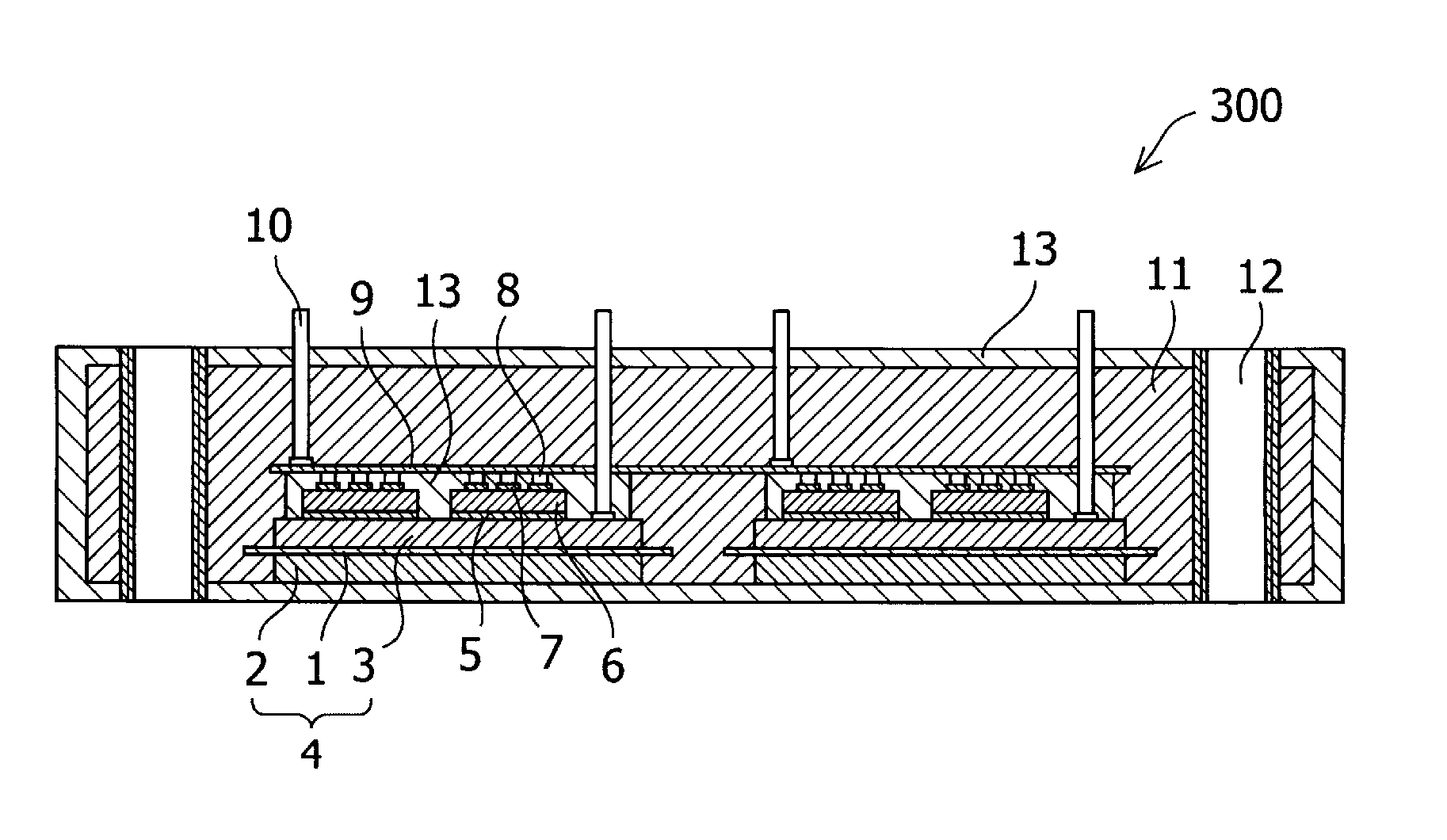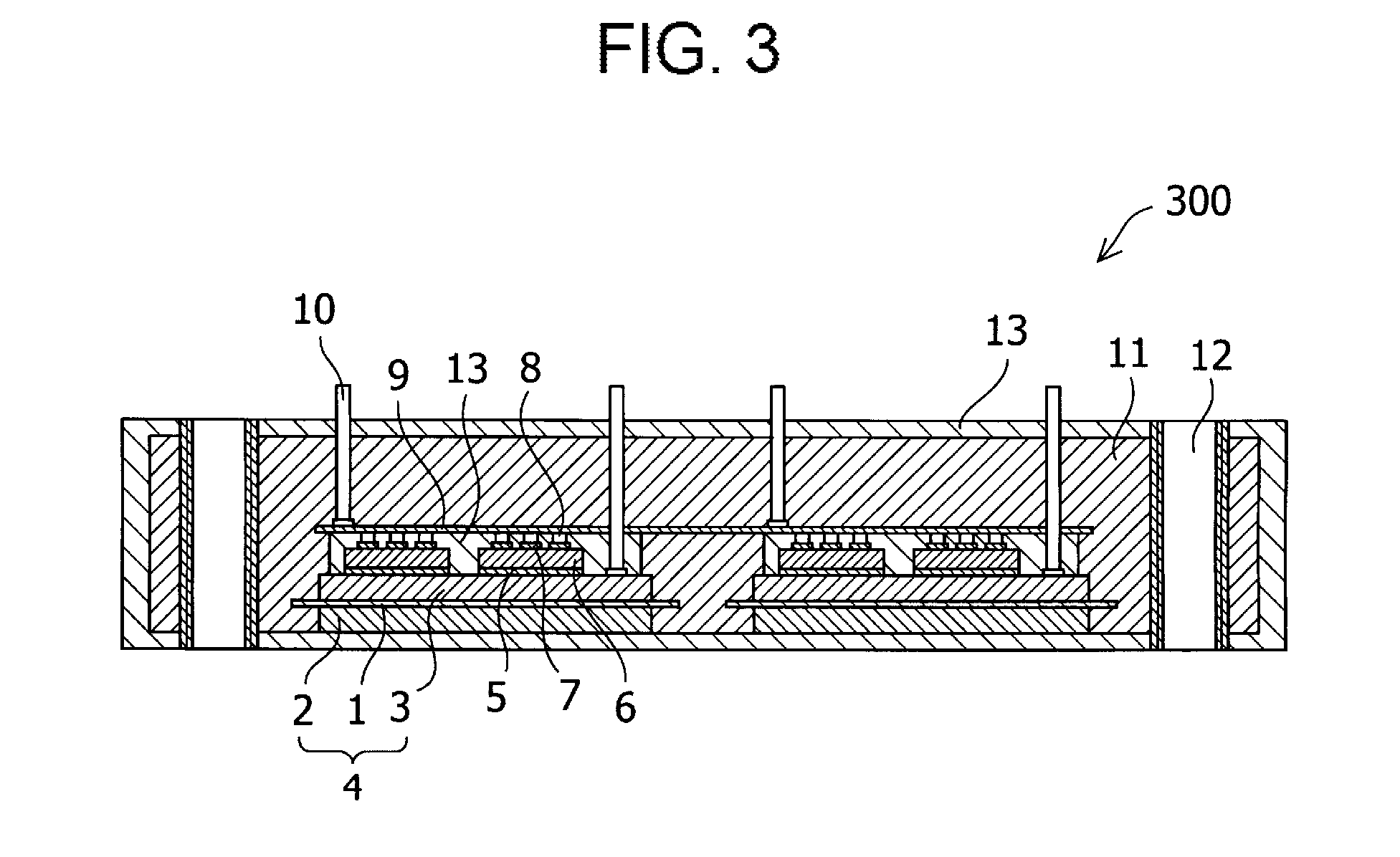Semiconductor device
a technology of semiconductor elements and devices, applied in semiconductor devices, semiconductor/solid-state device details, electrical devices, etc., can solve the problems of increasing the temperature of the semiconductor element, the heat generated by the semiconductor element, and the deformation of the silicon gel, so as to prevent the occurrence of cracks, prevent the progress of thermal oxidation degradation, and improve the reliability of the semiconductor device
- Summary
- Abstract
- Description
- Claims
- Application Information
AI Technical Summary
Benefits of technology
Problems solved by technology
Method used
Image
Examples
first embodiment
[0025]According a first embodiment of the invention, a semiconductor device includes: a molded body that is obtained by sealing, with a sealing material, a member including a semiconductor element, an insulating substrate which is bonded to one surface of the semiconductor element, and a printed circuit board which is used for a connection to an external circuit and is bonded to the other surface of the semiconductor element; and a sealing portion with a two-layer sealing structure in which a first sealing material that is a nanocomposite resin including an epoxy base resin, a curing agent, and an inorganic filler with an average particle size of 1 nm to 100 nm forms a first sealing layer that covers the semiconductor element and is provided in a region adjacent to the semiconductor element and a second sealing material that is a thermosetting resin, a thermoplastic resin, or a mixture thereof forms a second sealing layer that covers the first sealing layer and forms an outer surfac...
second embodiment
[0049]According to a second embodiment of the invention, a semiconductor device includes a molded body that is obtained by sealing, with a sealing material, a member including a semiconductor element, an insulating substrate which is bonded to one surface of the semiconductor element, and a printed circuit board which is used for a connection to an external circuit and is bonded to the other surface of the semiconductor element. A second sealing material which is a thermosetting resin or a thermoplastic resin forms a first sealing layer that covers the semiconductor element. A first sealing material which is a nanocomposite resin forms a second sealing layer that covers the first sealing layer, faces at least a portion of an outer surface of the molded body, and is provided with at least a thickness of 300 μm.
[0050]FIG. 2 is a diagram illustrating the cross-sectional structure of a semiconductor module molded structure 200 which is an example of a semiconductor device according to t...
third embodiment
[0059]According to a third embodiment of the invention, a semiconductor device includes a molded body that is obtained by sealing, with a sealing material, a member including a semiconductor element, an insulating substrate which is bonded to one surface of the semiconductor element, and a printed circuit board which is used for a connection to an external circuit and is bonded to the other surface of the semiconductor element. A first sealing material which is a nanocomposite resin forms a first sealing layer that covers the semiconductor element and is provided in a region adjacent to the semiconductor element. A second sealing material which is a thermosetting resin or a thermoplastic resin forms a second sealing layer that covers the first sealing material. The first sealing material which is the nanocomposite resin forms a third sealing layer that further covers the second sealing material, faces at least a portion of an outer surface of the molded body, and is provided with at...
PUM
| Property | Measurement | Unit |
|---|---|---|
| particle size | aaaaa | aaaaa |
| operating temperature | aaaaa | aaaaa |
| thickness | aaaaa | aaaaa |
Abstract
Description
Claims
Application Information
 Login to View More
Login to View More - R&D
- Intellectual Property
- Life Sciences
- Materials
- Tech Scout
- Unparalleled Data Quality
- Higher Quality Content
- 60% Fewer Hallucinations
Browse by: Latest US Patents, China's latest patents, Technical Efficacy Thesaurus, Application Domain, Technology Topic, Popular Technical Reports.
© 2025 PatSnap. All rights reserved.Legal|Privacy policy|Modern Slavery Act Transparency Statement|Sitemap|About US| Contact US: help@patsnap.com



